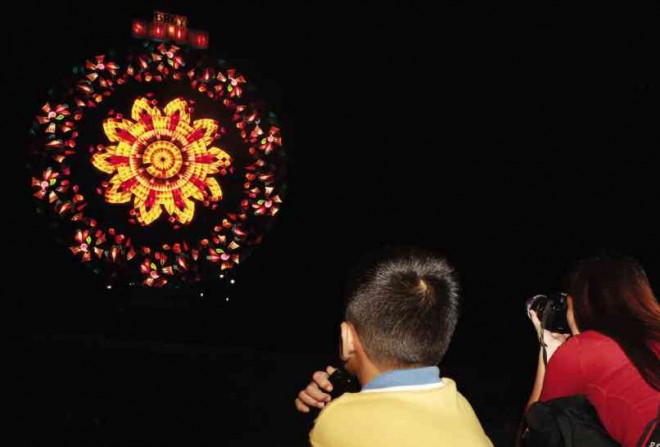A 50-year love affair with lanterns

A GIANT “PARUL” (Christmas lantern), a product of craftsmen from the City of San Fernando in Pampanga province, entertains spectators at the 2014 Ligligan Parul (Giant Lantern Festival). E.I. REYMOND OREJAS
SAN FERNANDO, PAMPANGA—This Christmas, 67-year-old Ernesto Quiwa counts 50 years of making giant lanterns.
In this capital city of Pampanga province, the Christmas capital of the Philippines, Quiwa is widely acknowledged to have helped keep the Catholic tradition alive, showing as well that the craft can sustain hundreds of families year-round.
For all the feats that are credited to him by cultural heritage advocates, including bringing the lanterns to international festivals, the man only wants to be called a “magpaparul” (lantern maker).
“This is all I do, make lanterns,” Quiwa, Tatang Erning to his 200 or so workers, told the Inquirer in Kapampangan.
It is the excellence and persistence that he pours in the craft that puts him in the league of master craftsmen Mario Datu and Jesus Manalang, said Ching Pangilinan, city tourism officer.
Article continues after this advertisement“His commitment to the craft is something we seldom see in a lifetime. Also, he ensured the continuity of the tradition in his family through his sons and grandsons,” Pangilinan said.
Article continues after this advertisementQuiwa is a great grandson of the first recorded maker of big lanterns, Francisco Estanislao, whose creation in 1908 was made of bamboo and coconut cloth. It was believed that Estanislao, variously described as vendor and salt maker, made the piece for the Christmas Eve Mass to attract the villagers of Sta. Lucia to church.
Estanislao’s daughter, Fortunata, married Severino David who, in the 1930s, made 16-foot lanterns that were lit by batteries from American military vehicles, according to his nephew, Angelo David, 82.
The union produced five boys and three girls. All five boys, especially Rodolfo, continued the tradition.
Rodolfo’s son, former Pampanga Board Member Robert David, designed the lantern-shaped roofs of the Paskuhan Village and the Bren Z. Guiao Convention Center, both in the city, in the 1990s. His sister, Milagros, is Quiwa’s mother.
Rodolfo and Milagrosí husband, Ruben, worked at the defunct Pampanga Bus Co. (Pambusco) as mechanics. The knowledge they derived from tinkering with the engines they probably applied on the lanterns, said Angelo David.
“At the instruction of Rodolfo, I operated the switchboard. This made the lights go on and off,” Angelo said.
Back then, he said, people contributed 50 centavos to a peso or food or labor to help make the big lanterns of villages near the town proper.
“During the festival, which was held at the old public market, there was a live band that provided the music to the lanterns’ dancing lights. The image of our patron Sta. Lucia was beside the lantern,” he said.
Why did the tradition pass on from one generation to the other?
Quiwa attributed this to the religious faith of clan members. “They believed the lanterns [represented] the Star of Bethlehem. It became a ‘panata’ (vow) for them to be making big lanterns during Christmas,” he said.
That star, according to the Bible, guided the Three Wise Men to the manger where the Child Jesus was born.
Quiwa’s profile reflects how far the lanterns have gone.
In 1964, he sold lanterns in Metro Manila by displaying these in gasoline stations and delicacy stores.
In 1966, he supplied the lanterns in Malacanang for a summit organized there by Sampaguita Pictures’ Jose Vera Perez. In 1969, he provided the 14-foot lantern for the inauguration of the theme park Nayong Filipino.
He exhibited four big lanterns in Samar and Leyte provinces at the request of then First Lady Imelda Marcos in 1970. He was also commissioned by the government, through then Tourism Minister Jose Aspiras, to decorate the outdoors of Fort Santiago with lanterns for the state visit of King Juan Carlos of Spain in the 1970s.
What he’s most proud about is he made the lanterns of Sta. Lucia that emerged as champion in the Giant Lantern Festival from 1972 to 1985.
In 1983, he displayed giant lanterns at the Cultural Center of the Philippines complex in time for the Manila International Film Festival.
Among Quiwa’s prized possessions is a letter through which the late President Corazon Aquino thanked him for the “Fatima peace lantern” he gave to her on Dec. 19, 1986. Quiwa said he was moved by Aquino’s role in the restoration of democracy after the ouster of the late strongman Ferdinand Marcos.